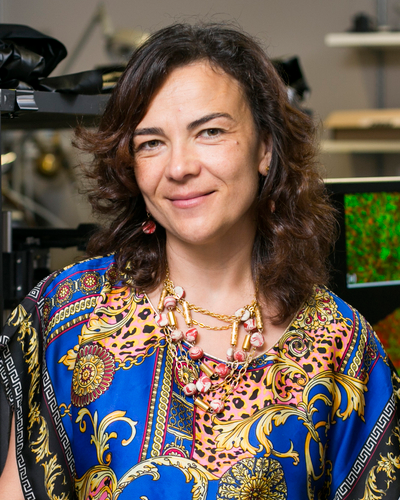Label-Free Monitoring of Metabolic Function with Micron-Scale Resolution: From Mitochondria to Humans
to

Irene Georgakoudi, Ph.D.
Professor, Biomedical Engineering Graduate Biomedical Sciences; Member, Cell, Molecular and Developmental Biology Program
Tufts University
Irene Georgakoudi has been working on the use of lasers for therapeutic and diagnostic applications since her undergraduate years. She started as a physicist at Dartmouth College and continued her graduate studies in biophysics at the University of Rochester. Her interests in spectroscopy and spectroscopic imaging using endogenous sources of contrast were founded during her postdoctoral years at the MIT Spectroscopy Lab. After working on the development of fluorescence-based in vivo flow cytometry while an instructor at the Wellman Laboratories for Photomedicine at Massachusetts General Hospital/Harvard Medical School, Georgakoudi joined Tufts in 2004. She is the author of several patents on the development and use of spectroscopy and imaging to characterize tissues or to detect specific populations of cells, and has published numerous peer-reviewed manuscripts, review articles, and book chapters on these topics. She is the recipient of a Claflin Distinguished Scholar, an NSF Career Award, and an American Cancer Society Research Scholar award. She has served on the Board of Directors of the Optical Society of America and she is an Associate Editor for the journal Optica. She is a fellow of the American Institute for Medical and Biological Engineering, Optica (previously the Optical Society of America) and the International Society for Optics and Photonics (SPIE).
Irene Georgakoudi's lab is interested in the development of new methods to assess different aspects of the normal or diseased development of human tissues that rely on light interactions with molecules that are naturally present in our cells and tissues. They are thus non-invasive (or minimally invasive) and do not require exogenous contrast agents. The goal is to generate high resolution (microscopic) images of tissues that provide not only morphological, but also functional information about the tissue by bringing the microscope to the patient, instead of using current approaches that rely on excising the tissue and processing it before looking at it under a microscope. These optical methods obviate the need for a biopsy and enable the study of the same specimen dynamically over time. They do not interfere with the physiology of the subject and they do not suffer from artifacts. Our expectation is that these methods will yield critical new insights regarding how conditions such as cancer, osteoarthritis, cardiovascular and neurodegenerative diseases develop and will provide a new paradigm for disease detection.
Summary
Cellular metabolism is essential for cellular and tissue function. Thus, it is not surprising that numerous diseases are associated with metabolic dysfunction. Metabolic responses are highly complex and dynamic in space and time over a wide range of scales. It is challenging to capture this important aspect of metabolic function without introducing artifacts using traditional radiographic, exogenous label, or mass-spectroscopy-based imaging approaches. Label-free, non-linear optical imaging modalities offer unique opportunities to overcome at least partially some of these challenges. Two-photon excited fluorescence is particularly well-suited to assess cellular redox state and mitochondrial dynamics through the intensity and lifetime signatures of NAD(P)H and FAD, two key metabolic co-enzymes. While their participation in a number of metabolic pathways confers great sensitivity to changes in metabolic function, interpretation of the origins of optical signal changes lacks specificity. Potential contributions from other fluorophores further complicate the interpretation and robustness of these signals. Multi-parametric analysis of the optical images and/or combination with other modalities that provide more specific genomic or proteomic information provide interesting opportunities to improve our understanding of metabolic function and its role in health and disease. Our studies performed with samples ranging from isolated mitochondria to living humans highlight some of these challenges and opportunities in the context of conditions such as cancer, aging, osteoarthritis, vitiligo, and traumatic brain injury.
Objectives:
*To understand the principles, unique opportunities and challenges associated with optical imaging of metabolic function in living specimens without the use of exogenous contrast agents.
*To understand how the micron scale resolution capabilities of optical imaging can be used to identify metabolic dysfunction associated with disease and treatment responses in living humans with cancer and vitiligo
*To appreciate the wide range of samples (isolated mitochondria, C elegans, engineered and excised tissues, humans) and biomedical problems (cancer, vitiligo, aging, osteoarthritis, neurodegenerative diseases) that can be assessed via label-free optical metabolic imaging
This page was last updated on Tuesday, March 21, 2023